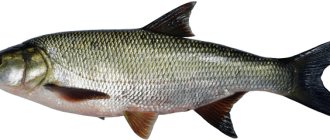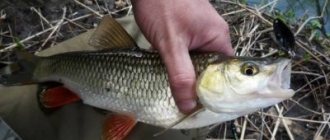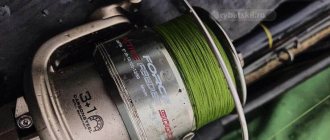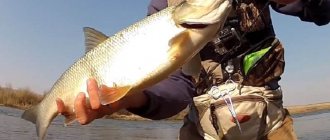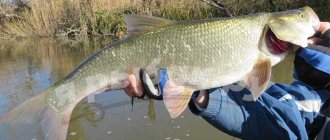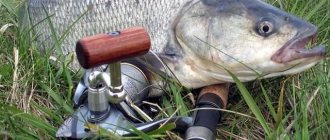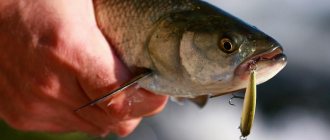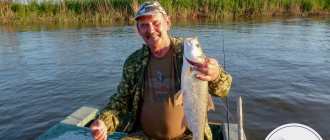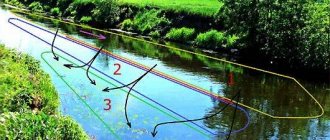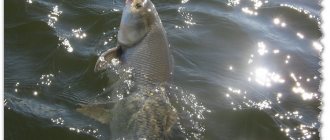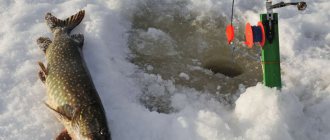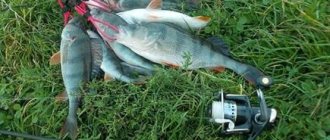Asp habitats. Where to look for asp?
The asp is very popular among fishermen, and they catch it with great interest and excitement.
Mostly the asp prefers to choose lowland rivers with a calm current for living, but it can often be found in lakes, as well as reservoirs that are artificially formed during the construction of hydraulic structures.
In warm seas, this fish leads a semi-anadromous lifestyle. In fresh water it prefers to feed on bleak.
Spawning and spawning
As soon as the first ice freezes the river, the asp is the first of the fish to go to wintering. It does not feed until the spring waters and comes out to spawn after the ide. This fish spawns unnoticed; it does it on riffles, without entering small rivers.
According to the classic of fishing literature Leonid Pavlovich Sabaneev, male asps fight over females during the spawning period. It happens that two males fight so hard that both come out of the duel severely wounded, and the cunning female, who silently watched them, eventually takes as her husband a third asp, who did not even participate in the duel for her sake.
After his “marriage,” the asp does not like to hunt and feeds on small, sedentary underwater inhabitants. At this time, it can be caught with fishing rods or donks if you put a fat, well-fed dung worm on the hook, but fishing on such days will not always be successful. However, after a while he begins to get really hungry.
The asp, by that time very hungry due to winter starvation and post-wedding malnutrition, begins to actively hunt for dace, roach, chub and even its relative, the bleak. The most active biting of the asp begins with the appearance of grasshoppers in the wild and their active chirping.
In addition to juvenile fish, the asp loves to eat various insects. Most often it stays in the upper layers of water, preferring solitude, although it can also be seen in a school. If a fisherman pulls this fish onto land, then the once very lively and noisy asp quickly becomes sluggish (lethargic).
It is very interesting to watch the process of asp hunting for fry fish. Ichthyologists have noticed that the asp, when attacking a small fish, tries to stun it with a blow of its tail. The fry gets scared and freezes, and the asp grabs such a gaping fish with his toothless mouth, always from the head.
Therefore, when catching an asp with live bait, must remember that the bait fish must be placed on the hook through the lower lip into the upper lip. A noisy fight between an asp is a sign that there are a lot of these fish in this place and you need to cast your fishing rods. The sound made by an asp during a fight with another male cannot be confused with anything, it’s like hitting the surface of the water with a shovel.
In fact, asps love to jump sharply out of the water and splash back noisily, repeating this several times. Unfortunately, due to the fact that the asp prefers to swim in the upper layers of water, it often becomes a victim of poachers. The fish gets caught in criminal rafting nets.
In nature, the asp loves to chase fry, so small fish are an excellent bait for them.
The best time of year for asp fishing
The most optimal time of year for asp fishing is early June and until autumn.
It is during this period that it is easiest to catch a large specimen, and the chances of catching at least something also become greater.
In principle, you can start trying from the moment the snow melts, but it should be borne in mind that when the water temperature still fluctuates at a low level, the fish hunts at depth, and not at the surface, so it is more difficult to distinguish the feeding areas of the asp, which complicates the process.
In summer, the water warms up, and he begins his hunt for prey in the upper layers, near the surface of the water, so that even the naked eye can see and hear it;
Closer to autumn, when the temperature begins to drop, it goes deeper and deeper again.
When to catch asp
Asp is a thermophilic and light-loving fish, therefore it is necessary to catch it in light and warmth. In cold seasons, it hibernates; at night, its activity also leaves much to be desired. When bad weather sets in, the asp also stops actively searching for prey and waits for the sun to come out. Therefore, it is recommended to catch asp in spring, summer and early autumn. On the warmest days, the asp swims along the very surface of the water, which slightly increases the chances of catching a good specimen.
Top 6 most popular ways to catch asp
There are several types:
On Spinning;
Fly fishing;
Donkoy;
Using a float rod;
Floating;
Path.
Catching asp with a spinning rod. Tackle, technique and fishing tactics
You need to start first of all with choosing the spinning rod itself - this is one of the main components of success.
The length of the fishing rod must be at least 1.4 m and no more than 2.7 m. The very size of the reservoir in which the event is planned should be taken into account.
However, for beginners it is best to choose a stick at least 2.7 m long, since the specificity of a spinning rod is that the longer it is, the easier it will be for you to cast.
The second very important and basic aspect of fishing is casting accuracy.
To make the task easier, it is recommended to equip the reel with thin mono or braided fishing line.
The rod's rings should be of good quality, and it is preferable to use a spinning reel.
The diameter of the first throughput ring should range from 30 to 35 mm. Experienced fishermen strongly advise against purchasing hard rods or overly fast spinning rods.
The asp resists much more energetically when it gets hooked, so a rigid rod can break under its pressure.
Techniques and tactics for catching asp: tips and tricks
In addition to equipment and types of bait, you should familiarize yourself with fishing techniques and tactics.
There are the following types of asp fishing techniques:
- "On the Splash" . This tactic is the most common for finding and fishing for a sheresper. It requires good attentiveness and speed of action. It involves determining the fishing location by the blows of the asp’s tail. After the place has been determined, you need to send the bait there and reel in the spinner. During this tactic, the bite is usually good, so the rod should be held very tightly;
- "Blindly" . This tactic is used in unfamiliar places. The whole principle of the technique is to slowly explore the upper and middle horizons. You need to act in all directions simultaneously. If the asp does not show itself in any way, then there is no need to stay in one place for a long time, you need to further look for a more promising place;
Advantages of spinning reels. 3 main advantages
Easy and smooth glide;
Many models have a system that ensures casting range (ABS or Long Cast);
The gear ratio should be in the range of 5.1/1, and the spool diameter should be from 3000–3500.
Based on the experience of many professional and experienced fishermen, we can conclude that thick wattle nets in asp fishing are not sufficiently effective, so it is recommended to change the large diameter to a smaller one - in the range from 0.14 mm to 0.16 mm.
Such parameters will be enough to fight this wayward fish and will not frighten you with its size.
6 asps in 7 minutes per castmaster (video)
Tackle
Classic asp fishing involves the use of high-quality and powerful gear that allows long casts of heavy spoons. A spinning rod for asp fishing must have a sufficient margin of safety and be long-range. The fishing line should preferably be monofilament, which also affects the casting distance. Naturally, the fisherman must also master the long-casting technique.
When fishing for asp with jig, you can use the same gear as in coastal fishing for pike perch. There are no special requirements for ultralight, although for asp it is better to use a braided cord, since it is more durable than thin monofilament.
Fly fishing for asp
How to fly fish?
For such fishing, a 8-class rod is usually enough, but a 9-class rod is also possible. If the asp’s bite is in the active stage, then it is caught using a floating line and streamers or dry flies.
If hunting takes place at half-water level, then the line should be sinking and the bait of the appropriate class.
The most effective place to use fly fishing is in the shallows. When catching asp in this way, they usually use:
Various flies, grasshoppers and streamers of different colors;
The cockchafer is also well suited for such purposes;
Of the artificial flies, it would be optimal to use dry flies in a light color scheme.
In order to catch an asp in this way, it is important to choose the right equipment:
The cord must be floating or intermediate, and the undergrowth must be 2 to 4 m long;
Unlike spinning fishing, the fishing line should be thicker so that when the fish grabs the bait, it does not break.
Once the gear is selected, you can start fishing. To do this, having chosen a convenient place, you should throw the wire with flies across the current and hold them lightly. During the process, you can tighten the cord at different paces.
When fishing occurs in river flow conditions, it is necessary to pull the bait towards you, and if it occurs in standing water, then the pull should be carried out slowly.
Fly fishing for asp on the Dubossary reservoir (video)
The uniqueness of the asp
Asp, aka river pirate, aka grip, sheresper, horse, whiteness, whiteness. And he deserved all these nicknames. A pirate because he is constantly in an active search for food and it is almost impossible for small fish to hide from his rapid attack. Grip, because, despite the lack of teeth, even a relatively large fish will not be able to escape from its mouth. It received the name sheresper because it likes to spread out all its fins, and the horse because, when attacking prey, it jumps high out of the water and hits its surface with its powerful tail, trying to stun its victim. Well, whiteness and shine - for its unique color. Moreover, all these names are telling and only from them can the fisherman have a good idea of what kind of opponent he will have to fight on the rifts, near steep banks, on the current, not far from hydraulic structures and in other promising places.
You can read about the biological characteristics and habits of the asp here.
Asp baits. Top 5 best baits
There are several types of bait that are most effective for catching this type of fish.
Devon is the most complex bait, which is very difficult to make on your own and difficult to find in a store in terms of price and quality.
When choosing this bait, you need to consider several points:
It should rotate easily;
Good weight in relation to compactness;
It is best to take a bait of this type made of lead;
High rotation speed. It should be noted that for solid Devons it is lower than for combined ones, the blades of which are made of brass or copper.
It is best to fish using the simultaneous use of baits, 2 types - left rotation and right rotation.
Trihedron - the purpose of this device is fishing in the water column at almost any depth. This is especially true in the spring and autumn.
Due to the fact that the trihedron seems to fall into the water, it is most popular among fishermen because of its efficiency. Most often, hunting with this bait can be found in the Middle Volga, where pike perch are also caught with it.
Castmaster is rightfully called a universal type spinner. With its help, asp can be caught in different ways.
For example, in the summer, when fishing mainly takes place in the upper layer of water, they use castmaster lures at high speed, and with the arrival of cold weather, they throw them to the depths and pull them up with steps.
If fishing takes place from a cliff, then with the help of this bait the spoon is pulled to the surface using a stepwise method, but at a careful and slow pace.
Jig - used for fishing in cold water. The use of this bait is used in a step-type method.
First of all, it should be taken into account that in the autumn and spring the asp usually feeds near the bottom and especially likes riffles, and it is in such cases that jigs are most effective. On such fishing you can catch a fairly large individual of this type of fish.
Wobbler - provides maximum opportunities with minimal restrictions.
For example, this bait is effective even if the asp does not show itself in any way on the surface of the water. Then you need to stand with the current and throw the gear across the current and slowly pull it up. This method is very effective.
Or another method. You should choose a place on the edge with a shallow depth - about 30 m from the spit and cast. A very effective bait and justifies itself in catching asp.
Asp nutrition
With the arrival of spring, the weakened sheresper goes to spawn, practically forgetting about feeding. After spawning, the fish is so weakened that it is not able to catch even small fish. At this time, many worms enter rivers and lakes with melt water, which become salvation for the asp. As the fish regains its strength, it begins to hunt for the fry.
In the summer, when insects appear, the asp actively grabs beetles, flies and dragonflies that have fallen to the surface of the water. On stormy and rainy days, the fish go to the bottom, where they look for small fish, spindles, and worms. Over the course of three years of life, the fish manages to gain weight of more than 1 kg. And the sheresper becomes a predator in the second year.
Tips for beginners. A few main rules on how to catch an asp
If a person has never gone fishing for asp, he will need to know at least the basic method of catching this fish.
The traditional method of catching asp is using a spinning rod. To do this, you will need to equip it with propeller-type spinners called “Devon”.
With this kind of gear you need to cast a little further than the spots where the fish splashes.
The asp swallows the spinner the moment it sinks into the top layer of water, so further actions require accuracy and speed.
In some cases, the fish swallows the “Devon” immediately, at a moment when the casting circles have not yet dispersed; at such moments, the asp begins to actively hunt for it and the illusion of a “game” is created.
After the fish grabs the bait, the line suddenly becomes tense, a jerk is felt at this very moment, you need to hook, but with great care, since either the line or the asp’s mouth may break.
When the fisherman is convinced that the fish is on the hook, the line must be lowered and slowly reeled in so that it can be carefully brought to the shore.
If the asp was hooked correctly, then its behavior is predictable - it will either try to go downstream or go to a depth opposite to the fisherman.
At this stage, it is important not to loosen the tension of the fishing line, since this type of fish is very shy and may try to break away several times, which will lead to the breaking of the fishing line or damage to its oral cavity.
When carrying out competent actions and following all the rules, the chances of successful fishing even for beginners increase several times.
How to properly catch an asp using live bait
The tactics of this fishing differ from the classical one and are more similar to fishing for perch and small pike using a running bottom. The fisherman casts the equipment at a given distance and floats it downstream, controlling the speed of descent and the trajectory of movement using the rod and line tension.
After passing through the promising zone, the equipment should be reeled out and re-cast. Depending on the fishing conditions, the angler can stand still, performing a short retrieve, or move along the shore, allowing the bait to travel a long distance.
When fishing with live bait using rafts, one must not forget about camouflage. The asp has good eyesight and hearing. Any suspicious object on the shore will alert him, and the predator will refuse to attack the bait. If the tackle does not involve long casting, then you should not wear bright clothes. It can be useful to hide behind coastal bushes. Try not to make noise.
When fishing with donkeys, you do not need to move along the shore. The gear is installed permanently, and the equipment is located at the bottom. The fishing range, as a rule, is not lower than average. In this case, camouflage will not hurt, but is not necessary. The main thing is to be quiet, don’t shout or stomp.
About live bait and bait methods
The best live bait for catching asp will be the one that represents its natural food. The predator feeds mainly on bleak, so the choice in its favor is obvious. Also suitable:
- perched water;
- small roach;
- juvenile chub;
- gudgeon.
The size of live bait is 5–10 cm. It is important to keep it as fresh and active as possible, since the listed fish species quickly fall asleep, losing their attractiveness to the sheresper. To do this, the bait must be stored in appropriate conditions, changed regularly, and placed correctly on the hook.
There are two main options for placing live bait on a hook: by the lips and through the gills with output through the mouth. The second method is more reliable, since the fish confidently stays on the double or single and does not fly off during splashdown or when biting an asp.
Recommended reading: How to catch an asp using a spinning rod
Biting, hooking and fishing
The asp grabs the bait sharply. The bite rarely looks blurry, without a characteristic jerk.
Hooking is often not required, since the fish itself sits securely on the hook. The fisherman only performs a “duty” short swing of the rod in order to minimize the likelihood of getting lost when fishing.
Once on the hook, the predator makes sharp, strong jerks, moves to the side, and can go to the surface, where it makes pirouettes, trying to free itself. Despite a powerful start, it quickly fizzles out and weakens. When bringing the asp to the shore, it is better to use a landing net, although experienced fishermen calmly take it with their bare hands.
Where to catch big asp
A large asp looks for places where the whirlpools end to attack; smaller asps hunt in the middle layers of the whirlpool; you need to cast skillfully, since two fish attacking at the same time is a rare occurrence. Catching a large asp is no longer a game; it requires a lot of patience and the ability to withstand the blow that attacks specimens over 2 kg.
One of the ideal places for catching large asp is plums, if they are wide and have sufficient depth, with a rocky bottom surface. If there is a significant current, you need to look for places where there are boulders. It is where the whirlpools end and calm water begins that the small fish rest, in such places the asp liked to attack prey suddenly and swiftly, an experienced fisherman knows this and therefore prepares to hook the strike immediately, from the moment of casting. Valuable information: before each exit, check the integrity and elasticity of the hooks: the blows are sometimes so strong that the hook cannot withstand and unbends. But that’s not all; hooking is often not necessary, the main thing is to withstand the blow; inexperienced fishermen can release the rod out of surprise.
In places where there are cliffs, you need to look for trees and logs that have fallen into the water, you need to fish the place, try to cast both with the current and against it. You need to look for places where there is no drift of sand grains, clay soil is best, large asp loves just such places. But underwater spits are a favorite stopping place for schools of large asp, experienced fishermen adore these places, they will certainly be lucky here and often their hopes are justified. In such places it is easiest to catch fish; this is a rather difficult task: an asp can quite exhaust its hunter.
Fishing for asp in winter in open water
This large carp fish is also caught in winter. Moreover, the silver beauty is caught both in open water on non-freezing reservoirs and from ice. As soon as the winter cold sets in, the asp fights known to all fishermen end. This predator descends closer to the bottom, as these are its new places for hunting in winter.
In winter, asps are successfully caught on city canals and reservoirs not covered with ice. Such reservoirs usually have many tributaries in the form of springs and springs. The water there is warmer than in frozen reservoirs. Therefore, there is a lot of oxygen needed for fish. This makes the asp active, although he is no longer as violent as he was in the spring and summer.
In winter, people fish for asp in open water using a spinning rod. But there are many nuances to such fishing. Firstly, you need to dress warmly. Secondly, the reel often jams and the line freezes. And thirdly, it is more difficult to find an asp in winter, since there are no visible fights of this predator.
The fish does not slap its tail on the surface of the water and therefore you have to look for it blindly. But if you wander with a spinning rod in your hand through those parts of the reservoir where there are a lot of small fish, then fishing can be successful. In order not to frighten the aquatic inhabitants, you need to dress in camouflage-colored fishing clothes or just a dark-colored suit.
In winter, finding and catching an asp is very rare.
But a bright jacket will scare the already suspicious winter fish. The juvenile fish will be frightened, and after them the large representatives of the ichthyofauna. Experienced fishermen should wear white clothes to match the color of the snow. Such costumes are usually worn by snowshoe hare hunters in a snowy forest.
From a boat you can successfully catch asp using wobblers or jig baits, which are sold in a large selection in our fishing stores. Wiring is carried out at random at the edge of deep holes and near the bottom.
You can use artificial baits such as twisters, which in Central Russia in December sometimes catch asps weighing ten kilograms in open water. For such fishing, it is better to use not a braided line, but a monofilament thread, which is not so visible to the asp.
Typically, a fishing line with a thickness of 0.27-0.30 millimeters is chosen. If in these places, in addition to asp, large pike also live, then you can put a metal leash. After all, pike teeth, unlike asp teeth, are very sharp and can bite through the thickest monofilament line.
Sheer fishing with a spinning rod also gives good results. They use spinners that resemble topwater fish or spinner spoons. When flashing like this, you need to alternate jerks with five-second pauses.
Catching asp from ice in winter
In winter, asps are also caught from the ice, but this fishing method is rarely used. Ice fishing for this predator is possible in those reservoirs where in winter there is a lot of oxygen under the ice that saves the fish. Sometimes a fisherman goes purposefully to catch a chub and instead comes across an asp, which also makes fishing exciting and memorable.
With long jerks, the donkey with a large leash should be set off with the current and pulled towards the cut hole. Asp from the ice are lured on vertical spoons, usually silver, or caught on a fishing rod with a large jig. A piece of fish is usually placed on a jig.
Ice fishing for asp is a difficult, but at the same time exciting activity. Difficulties are associated with the dependence of bites on weather conditions. Usually, with a sharp drop in atmospheric pressure, the desired prey turns out to be just a dream.
But at the same time, such fishing is distinguished by its sporting nature and therefore will undoubtedly gain popularity in our country. In the meantime, the caste of perch fishermen, zander fishermen and those who like to fish for pike from ice is noticeably superior to the community of connoisseurs of asp fishing in winter from ice.
When is the best time to catch a large asp?
The large asp begins to catch immediately after the ice melts; it is mostly at greater depths, but shortly before the spawning period, it comes to the shallows. After spawning, the fish take the bait poorly for a long time, and only with the onset of real warmth do large fish begin to take the bait.
This type of predator is not characterized by night hunting, so if the fisherman plans to catch asp, it is not necessary to interrupt his sleep at the most interesting place at night. Very occasionally there are cases when at dawn you can hear the hunting of a flock, but this is precisely that rare moment that is not typical in the behavior of an asp.
The asp hunts in packs, it is found both in seething streams near dams and under the shore, near high cliffs, which means that different fishing techniques are used. The factor that you should pay attention to is the food supply, for a particular place, it can be different, but the asp’s love for bleaks is no secret to anyone.
The very place where the fish feeds is not difficult to hear; fishermen determine it by the slaps of their tails hitting the water. The flock uses a unique hunting tactic: the fry is, as it were, pushed closer to the surface, and then drowned out by strong blows of its tails on the water surface. Those three or four seconds, while the fry is not able to think in a stunned state, are quite enough for it to end up in the asp’s stomach.
It is this sound of clapping on the water that you need to focus on, but initially it is important to find out exactly how the flock moves and an experienced fisherman can determine this well. In a school there will always be a couple or three large specimens of fish, and catching a large asp is not in a hurry, even amid the general noise and confusion, the fish does not lose caution.
